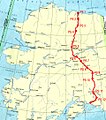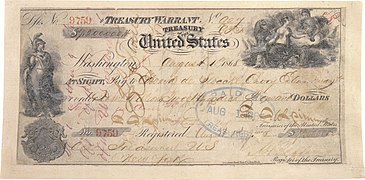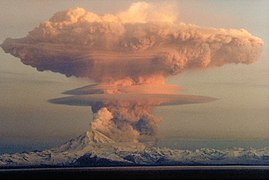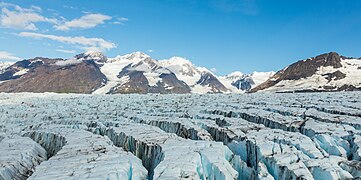Portal:Alaska
 Introduction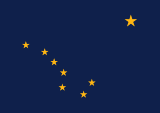   Alaska (/əˈlæskə/ ə-LASS-kə) is a non-contiguous U.S. state on the northwest extremity of North America. It is in the Western United States region and is considered to be the northernmost, westernmost, & easternmost (Aleutian Islands cross 180°, and go into the eastern hemisphere makes it the most eastern) state in the United States. To the east, it borders Canada (the Yukon territory and the province of British Columbia). It shares a western maritime border, in the Bering Strait, with Russia's Chukotka Autonomous Okrug. The Chukchi and Beaufort Seas of the Arctic Ocean lie to the north and the Pacific Ocean lies to the south. Technically a semi-exclave of the U.S., it is the largest exclave in the world. Alaska is the largest U.S. state by area, comprising more total area than the next three largest states of Texas, California and Montana combined, and is the seventh-largest subnational division in the world. It is the third-least populous and most sparsely populated U.S. state, but is, with a population of 736,081 as of 2020, the continent's most populous territory located mostly north of the 60th parallel, with more than quadruple the combined populations of Northern Canada and Greenland. The state contains the second-largest and largest cities in the United States by area: the state capital of Juneau, and its former capital, Sitka, respectively. The state's most populous city is Anchorage and approximately half of Alaska's residents live within its metropolitan area. Indigenous people have lived in Alaska for thousands of years, and it is widely believed that the region served as the entry point for the initial settlement of North America by way of the Bering land bridge. The Russian Empire was the first to actively colonize the area beginning in the 18th century, eventually establishing Russian America, which spanned most of the current state, and promoted and maintained a native Alaskan Creole population. The expense and logistical difficulty of maintaining this distant possession prompted its sale to the U.S. in 1867 for US$7.2 million (equivalent to $157 million in 2023). The area went through several administrative changes before becoming organized as a territory on May 11, 1912. It was admitted as the 49th state of the U.S. on January 3, 1959. Abundant natural resources have enabled Alaska—with one of the smallest state economies—to have one of the highest per capita incomes, with commercial fishing, and the extraction of natural gas and oil, dominating Alaska's economy. U.S. Armed Forces bases and tourism also contribute to the economy; more than half the state is federally-owned land containing national forests, national parks, and wildlife refuges. It is among the most irreligious states, one of the first to legalize recreational marijuana, and is known for its libertarian-leaning political culture, generally supporting the Republican Party in national elections. The Indigenous population of Alaska is proportionally the second highest of any U.S. state, at over 15 percent, after only Hawaii. (Full article...) Entries here consist of Good and Featured articles, which meet a core set of high editorial standards.
The Alaska-class were six large cruisers ordered before World War II for the United States Navy (USN), of which only two were completed and saw service late in the war. The USN designation for the ships of this class was 'large cruiser' (CB), a designation unique to the Alaska-class, and the majority of leading reference works consider them as such. However, various other works have alternately described these ships as battlecruisers despite the USN having never classified them as such, and having actively discouraged the use of the term in describing the class. The Alaskas were all named after territories or insular areas of the United States, signifying their intermediate status between larger battleships (which were mostly named after states) and smaller heavy and light cruisers (which were named after cities). The idea for a large cruiser class originated in the early 1930s when the USN sought to counter the Deutschland-class "pocket battleships" being launched by Germany. Planning for ships that eventually evolved into the Alaska-class began in the late 1930s after the deployment of Germany's Scharnhorst-class battleships and rumors that Japan was constructing a new large cruiser class, the B-65 "super cruiser." To serve as "cruiser-killers" capable of seeking out and destroying these post-treaty heavy cruisers, the class was given large guns of a new and expensive design, limited armor protection against 12-inch shells, and machinery capable of speeds of about 31–33 knots (57–61 km/h; 36–38 mph). Of the six planned, Alaska and Guam were the only two to be completed; a third, Hawaii, was still building at the war's end and had its construction suspended on 16 April 1947, while the remaining three were cancelled. Alaska and Guam served with the USN for the last year of World War II as bombardment ships and fast carrier escorts. They were decommissioned in 1947 after spending only 32 and 29 months in service, respectively. (Full article...)TopicsCategoriesSelected article - The question of whether to drill for oil in the Arctic National Wildlife Refuge (ANWR) has been an ongoing political controversy in the United States since 1977. As of 2017, Republicans have attempted to allow drilling in ANWR almost fifty times, finally being successful with the passage of the Tax Cuts and Jobs Act of 2017. ANWR comprises 19 million acres (7.7 million ha) of the north Alaskan coast. The land is situated between the Beaufort Sea to the north, Brooks Range to the south, and Prudhoe Bay to the west. It is the largest protected wilderness in the United States and was created by Congress under the Alaska National Interest Lands Conservation Act of 1980. Section 1002 of that act deferred a decision on the management of oil and gas exploration and development of 1.5 million acres (610,000 ha) in the coastal plain, known as the "1002 area". The controversy surrounds drilling for oil in this subsection of ANWR. Much of the debate over whether to drill in the 1002 area of ANWR rests on the amount of economically recoverable oil, as it relates to world oil markets, weighed against the potential harm oil exploration might have upon the natural wildlife, in particular the calving ground of the Porcupine caribou. In their documentary Being Caribou the Porcupine herd was followed in its yearly migration by author and wildlife biologist Karsten Heuer and filmmaker Leanne Allison to provide a broader understanding of what is at stake if the oil drilling should happen and educating the public. There has been controversy over the scientific reports' methodology and transparency of information during the Trump administration. Although there have been complaints from employees within the Department of the Interior, the reports remain the central evidence for those who argue that the drilling operation will not have a detrimental impact on local wildlife. (Full article...)Selected picture - Alaska wild berries from the Innoko National Wildlife Refuge. Photo credit: US Fish and Wildlife Service General imagesThe following are images from various Alaska-related articles on Wikipedia.
Recognized content
Featured articlesGood articles
Featured pictures
Former featured pictures
Related Portals
Related WikiProjectsState facts
State symbols:
Tasks
Associated WikimediaThe following Wikimedia Foundation sister projects provide more on this subject:
Discover Wikipedia using portals |





